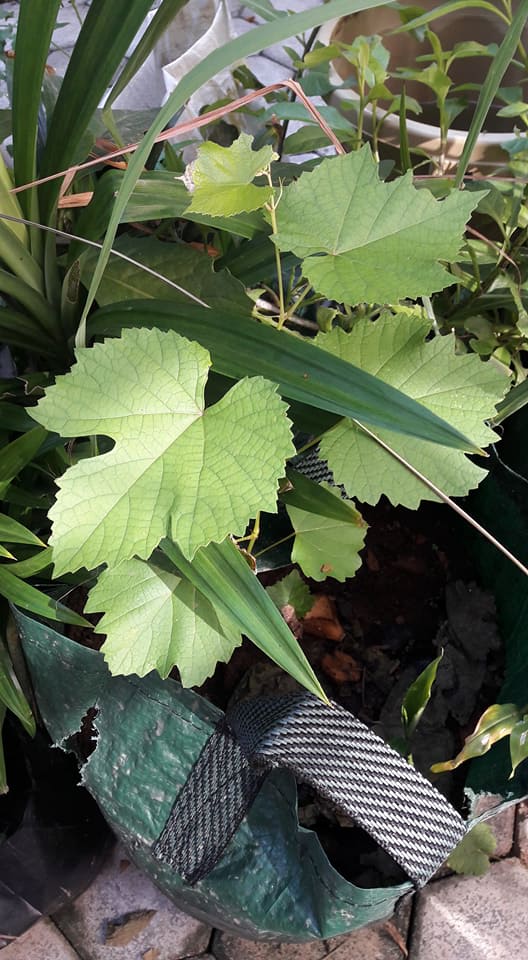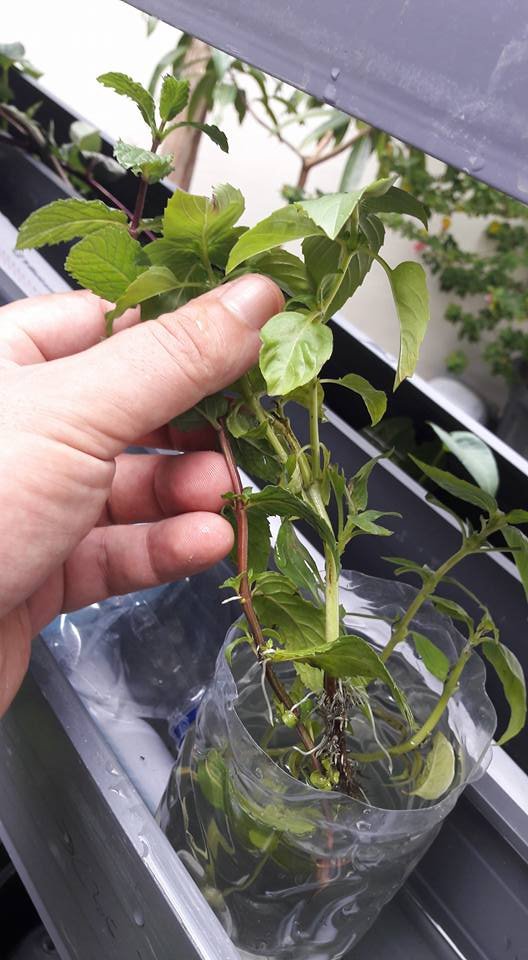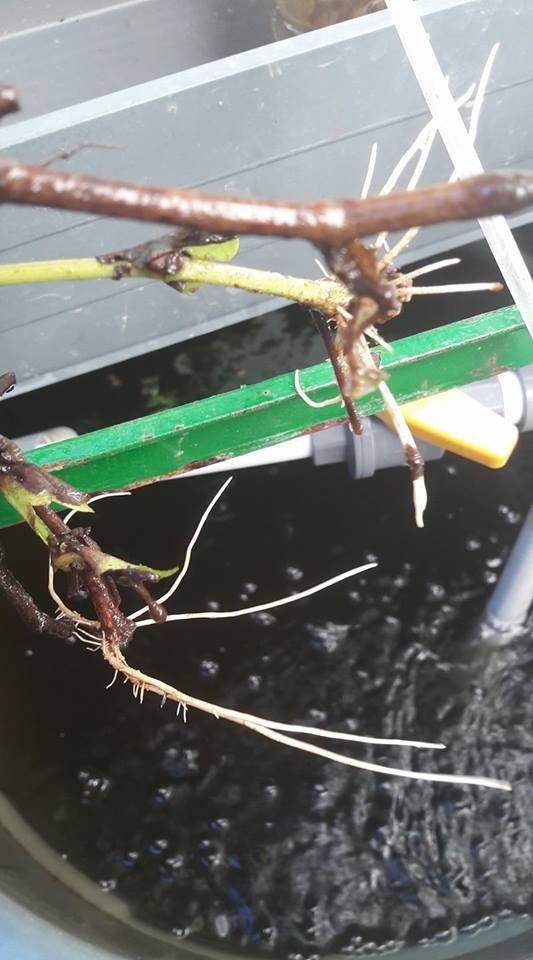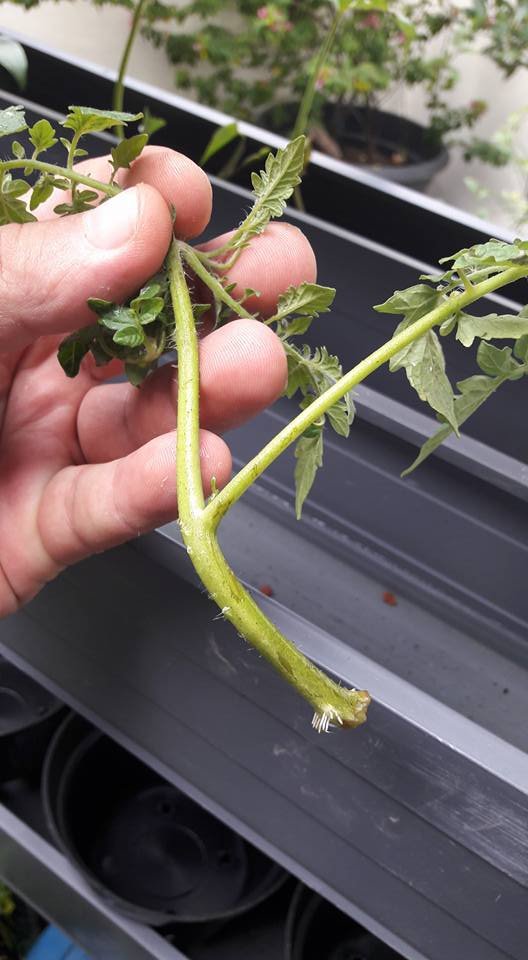How to make Grape and Tomato plants in the summer for sale or gifts, using a bubble cloner
Revs' Teks and Tips #1
Hello, Steem Community! This is my first Teks and Tips post where I show you how some techniques I've developed. I like to grow and build things and simplicity is a key desire. This post is about a way to grow softwood grape cuttings in the tropics, or in summer with minimal equipment and expense

This Isabella grape is a type well suited to tropical and subtropical cultivation. However, in this Tek im trying Syrah/ Shiraz wine grapes
My interest in capturing grapes started when had just turned 18, as I was exploring riverbanks in Western Australians southwest, near a town called Boyanup. I was searching for freshwater crayfish, Marron, a delicacy of the region, and I chanced across a huge wild grapevine which was laden with fruit. Gorging myself on these delicious grapes I could see this was an old seedling vine possibly seed dropped by a bird or perhaps a discarded pip from another camper. The flavor was excellent and its size was as large as store bought table grapes.
This was at a time when I was developing my first Permaculture gardens and I was busy learning how to propagate plants and about the many edible plants and different varieties. I started wondering again why grapes were so expensive from nurseries when they grew so prolifically. Growing grapes from hardwood cuttings is very easy, but it was the wrong season, it was Summer, and so I never did capture that seedling variety.
Now I live in Indonesia and though I’ve become quite proficient at striking cuttings in temperate and subtropical areas, once I moved to the tropics I found that things didn’t work like they did before.
Again here due to rarity, grape plants are expensive. While I winced at paying AUD $13-$19 for vines in retail Australian nurseries, here in Indonesia quality cultivars sell for much more while the earning power of the average person is only 1/10. This is a major impediment to people wishing to start cottage industries that could otherwise greatly improve their livelihoods.
Traditional hardwood and semi-hardwood cutting methods have problems in the tropics where microbial activity is in overdrive, causing rot. Consistently high temperatures affect the metabolism of plant so that they often do not enter states of dormancy, in addition, the overly high temperatures can impair root development and cause cuttings to dry out before they have time to root
In the tropics many plants including grapes never enter a period of dormancy as in cooler regions, this also affects the ability to harvest suitable material for conventional cuttings.
Even in cooler areas, if one finds a plant of interest, while in vegetative growth we can miss the opportunity to propagate until winter, thereby losing a valuable season of potential growth.
When Opportunity strikes to capture a superior plant and bring it into cultivation we need a method that can be used on green softwood material. So I looked into and experimented with several methods Aeroponic cloning and the Simple “Grandma” Tek of simply rooting plants in a glass of water.

The Simple "Grandma Tek" is to just root plants in a glass of water. This works well for very fast rooting plants like this Bush Basil
However, I hit obstacles again due to microbes and temperature, the water would turn stagnant in the Grandma Tek, While the Ghetto rig Aeroponic cloner was partially successful the enclosed space often gets too hot, when temperature exceeds 30 degrees Celsius the rooting process can be inhibited. In subtropical climates, the cooler nights make this a viable option but up here nearer the equator the night time temperature is above 28C and daytimes average 32-34C.
Commercially, misting systems are used but these also increase the risks of fungal attack, and they involve more specialized equipment, more chance of blockages, loss of pressure from intermittent supply. Where I live is well outside the realms where specialized items are available, and so failure is a high risk. We could use fungicides and sterilizing agents to reduce fungal attack but I prefer to limit exposing myself and my plants to harsh chemicals.
What I have tested is a very simple Ghetto Tek that is a fusion of Aeroponics and the Grandma Tek. It is cheap, effective and anyone anywhere in the tropics can do this proved they have access to any AC power supply. No chemicals are required and the cuttings will begin to root within two weeks
Materials
- Grapevine prunings of a healthy vine in active growth
- Plastic or glass jar 1.5L
- Water – Tap water, or I used water from my fish tank
- Aquarium air pump 5 Watts
- Air stone
- Aquarium tubing
- Manifold for tubing (optional if you want to set up a bank of these)
- Household Chlorine bleach, or Hydrogen peroxide 3% (optional)
- A bucket if using bleach
- Scissors, secateurs or pruning shears
Method
- Take Cuttings, preferably in the cooler time of day and take to a shaded area to trip the leaves. This is the most critical window for success, do not leave them exposed to wilt or your success rate will drop dramatically. If you must collect from far away wrap them in a damp cloth and put in a plastic bag.
- Cuttings should be ideally be 15-25Cm in length with leaves attached, though ive struck them as short as 5cm.
- Remove 80% of the leaf area, including all leaves on the lower 10cm, and then cut back the Upper leaves by 2/3
- Cut the top off the plastic bottle and fill ¾ with water. You can use tap water, however, I chose to experiment using water from my fish tank as it seems to have some kind of growth promoting factors, maybe just the Nitrate or possibly some other components from the fish or established microbes. Anecdotally, Fish tank water appears to have some inhibitory effect on root rot fungi. At this stage, the cuttings do not need any fertilizer, just water.
- Connect the air pump, tubing, manifold (if you are setting up multiple bottles) and set the air stone at the base of the Bottle. Turn it on
- You may wish to surface sterilize the grape cuttings, especially if you’ve collected them from another garden. Using a solution of Household chlorine bleach or 0.15% Hydrogen peroxide for 10 minutes.
- To make the mix
6a. Chlorine bleach
one-part bleach to 9 parts water for 5% solution is often recommended. Though it’s better to use less than more. For example, for a 5L bucket of water, add 2 capfuls of bleach, I find this rate does the job. If you can smell the Chlorine, then it’s enough to do the job given enough time.
6b. Hydrogen peroxide
1.5 teaspoons per 5L water
Hydrogen peroxide is much safer to plants but not as easy to find as Chlorine bleach. Both work and I wouldn’t go out of my way to find one of the other.
Submerge the cuttings in the solution and agitate several times over 10-15 minutes with a stick. This will kill spores and microbes that may have hitched a ride from another garden.
Remove cuttings and rinse well under clean water for 5 minutes
It is a basic sanitation method. But for the record, I didn’t do this. My cuttings are from my own garden and I did not use any, but I have in the past.
Place the cuttings in the bottle and set the bottle in a sunny to a part shaded area. It should get around 5 hours of direct sunlight per day. In the tropics, the sun is so intense that up to 30% shade is still strong enough to be classed as “Full sun”.
Over the next few days watch the bottle and if the water taints or leaves fall in and rot then promptly change the water. After about 5 days it should stabilize and any leaves that will fall off have already fallen off.
As it stabilizes by about the 10th day white bumps appear on the stem, and the base may swell slightly. Before the 14th day at ambient tropical temperatures, white roots should appear and begin to grow rapidly. I didn’t note the exact day as I was in another city for 5 days and the system ran on autopilot.Now be patient. This time is the second most critical window for success.
It won’t hurt them at all to leave them longer for the roots to grow more. You can even lift them out and trim roots with clean sharp scissors (swipe cutting implement with bleach) to encourage further branching and root thickening.I’d say give another week and then pot up into a potting mix, coconut peat or compost and sand mix.
- To Pasteurize the mix and kill off harmful microbes fill the pots and pour boiling water from a kettle over the media. Allow it to cool. 100C water will drop to about 70-80C once it hits the media and then cool rapidly to the desired window of 45-60C that kills pathogenic microbes and insects. However, spores of beneficial microbes will survive and repopulate. And the alternative is to put a damp mix in a black plastic garbage bag and leave it a few days in the Tropical sun, this will have the same effect.
- Put your potted plants into a shady position for 4-5 days as their roots will grow root hairs to enhance water uptake. While in water the roots do not grow these but as soon as they are in the soil they are triggered to do so and the effect can be as short as 48 hours.
Now you have grape plants be sure to attach a label to remember what type and return them to a sunny position and commence fertilizing them as you would with other potted plants. Once roots are visible at the drainage points at the bottom of the pot they are ready for planting, gifting, sale or trade.
If you do try this method please post in comments or tag me in your results, I’d love to know how you went. I’m now trying this method with Sweet Acerola cuttings, another rare, expensive and delicious fruit
Results

These are cuttings that have been in for about 5 days and are stable

Between 11 and 24 days later they have these roots. I pruned them back by half to encourage more root growth, and returned to the bottle

Today I put in the Acerola cuttings collected yesterday, from our beach garden in Sumbawa. Once I've potted on the grapes i'll divide the Acerola cuttings up into several bottles.

The technique also works for Tomato. This is a prized Japanese Momotaro tomato i cloned with this method
Note on Quarantine
Grapes are a profitable crop and support livelihoods in many regions, please help protect these peoples interest by being aware of restrictions on the movement of grape cuttings and plants between regions.
There are ways to get certified plants or cuttings sent from accredited nurseries and agencies. If importing a new type to your region please follow these requirements, once you have one growing you can use this method I’ve shown to make many more, so consider group buys with fellow gardeners.
Suggested reading for cutting santitation
http://extension.oregonstate.edu/linn/sites/default/files/plant_prop.pdf
please Comment, Upvote, Share or Resteem!

Very good post. :)
Congratulations @reville! You have completed some achievement on Steemit and have been rewarded with new badge(s) :
Click on any badge to view your own Board of Honor on SteemitBoard.
For more information about SteemitBoard, click here
If you no longer want to receive notifications, reply to this comment with the word
STOPCool small grapes
nice post, i will practice it
I like your posts, you are amazing, I like what you have shared ,, hopefully we become good steemit friends
Upvoted, kindly feel free to upvote my post too please.https://steemit.com/economy/@chuxlouis/my-father-in-law-won-t-become-a-coder-no-way-no-matter-what-economists-say or other post there.